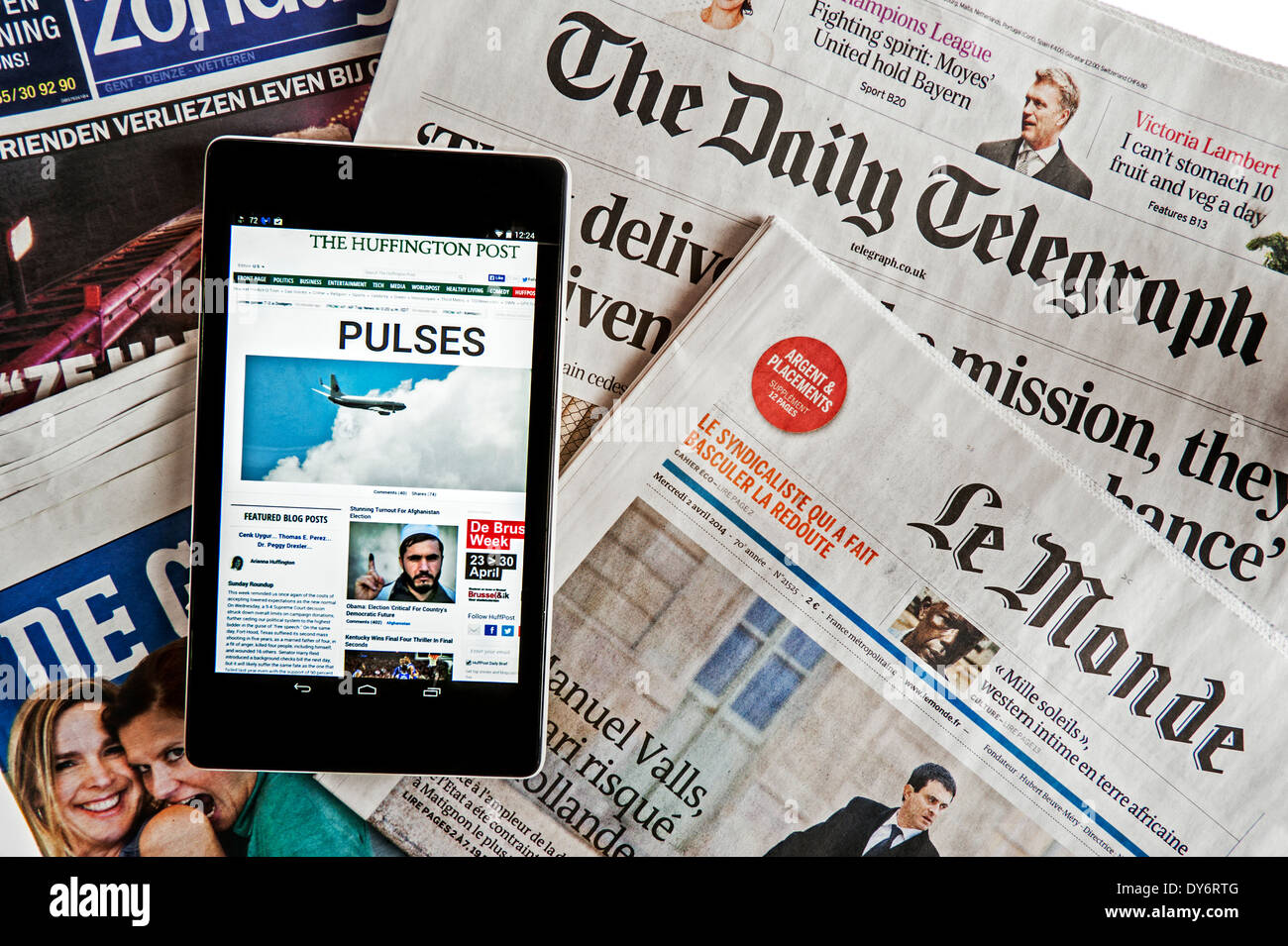The Influence of stnews.live on News Distribution
Wiki Article
The Influence of Social Media heading We Consume News Online
Social media has fundamentally transformed news consumption. It offers prompt access to info, typically eclipsing typical media electrical outlets. This fast dissemination comes with difficulties. Customers face the risk of running into misinformation and ending up being trapped in echo chambers. The formulas driving tailored content can cover diverse point of views. As these dynamics evolve, recognizing their implications ends up being essential for notified interaction in public discussion. What methods might help navigate this complicated landscape?The Advancement of News Intake in the Digital Age
As innovation advanced, the means people consumed news changed considerably in the electronic age (stnews.live). Conventional newspapers and relayed media began to decrease as the internet became a primary resource of details. On-line platforms supplied immediate accessibility to newspaper article, video clips, and podcasts, permitting customers to remain notified any time. The benefit of mobile tools further accelerated this change, making it possible for users to receive updates on the goIn addition, the surge of news collectors and web sites facilitated the consumption of diverse point of views, encouraging users to tailor their news intake based on individual interests. This advancement also prompted wire service to adapt their approaches, concentrating on digital material and appealing viewers via multimedia layouts. Because of this, the standard barriers of time and area in news delivery decreased, causing an extra prompt and customized news experience for target markets worldwide.
The Duty of Social Network Platforms in News Circulation
Social network platforms have transformed news circulation by supplying instantaneous accessibility to details. Their algorithm-driven web content curation frequently prioritizes interaction over precision, causing considerable reputation obstacles (stnews.live). As customers browse this landscape, the implications for news consumption and public discourse come to be increasingly intricateImmediate News Accessibility
Although traditional news outlets have actually long been the key source of information, the rise of social networks platforms has actually significantly transformed just how news is accessed and taken in. Instantaneous news gain access to has become a characteristic of the digital age, making it possible for users to obtain updates in actual time. Platforms such as Twitter, Facebook, and Instagram allow news to spread rapidly, frequently going beyond traditional media in speed and reach. Customers can share tales, comment on occasions, and involve with journalists, developing a dynamic interaction between the target market and news web content. This immediacy fosters a culture of seriousness, motivating users to look for info quickly. The assumption for timely news has reshaped journalistic methods, compelling news organizations to adapt their methods to fulfill the needs of a busy electronic atmosphere.Algorithm-Driven Material
While users actively involve with content on social networks, the formulas that govern these platforms play a crucial duty in identifying which newspaper article get presence. These algorithms evaluate individual actions, preferences, and involvement metrics to curate personalized news feeds. Because of this, specific stories might be enhanced while others stay odd, commonly prioritizing thrilling or trending subjects over substantive reporting. This careful direct exposure shapes individuals' assumptions of present events and affects public discourse. The dependence on algorithm-driven web content can develop echo chambers, where customers are mostly exposed to point of views that align with their very own beliefs. The dynamics of news distribution on social media platforms considerably influence exactly how individuals take in and analyze information in the electronic age.Reputation Challenges
As customers significantly turn to social media sites for news, the integrity of info encountered on these systems becomes a pushing problem. The decentralized nature of social media sites permits any person to publish material, typically obscuring the lines between trusted journalism and misinformation. Formulas prioritize engagement over precision, resulting in the extensive circulation of sensational or deceptive tales. This setting postures considerable obstacles for users attempting to recognize reliable sources. Social network systems, while venturing to deal with false information with fact-checking and material moderation, run the gauntlet for disparities and prejudices in their methods. Ultimately, the responsibility lies with customers to seriously evaluate the news they consume, as the fast spread of details frequently outmatches verification efforts by platforms.The Surge of Person Journalism and User-Generated Content
The rise of citizen journalism has empowered daily people to share news and viewpoints, typically providing understandings that conventional media might neglect. Nevertheless, this shift likewise offers significant difficulties, specifically the spread of false information that can develop from unverified material. As user-generated material ends up being much more common, the equilibrium between genuine voices and accuracy in coverage remains a vital concern.Empowering Day-to-day Voices

Obstacles of Misinformation
While the increase of person journalism has actually opened opportunities for diverse voices in the media landscape, it has additionally presented substantial obstacles associated with misinformation. The ease of sharing info through social media sites platforms enables individuals to distribute news rapidly, however this rapid spread frequently comes with the cost of precision. User-generated content regularly lacks the extensive fact-checking and editorial oversight that conventional journalism offers. Sensationalized or false narratives can obtain grip, misdirecting audiences and forming public assumption. Moreover, the blending of opinion and truth within social media sites makes complex the distinction in between credible information and misinformation. Because of this, consumers have to navigate a significantly complex media environment, needing essential thinking skills to determine trustworthy news sources in the middle of the sound
False information and Its Ramifications for Public Discourse
As social media sites platforms progressively dominate the landscape of details dissemination, the proliferation of misinformation postures substantial challenges for public discourse. Misinformation, often made to deceive or prompt emotional reactions, can misshape assumptions of fact and threaten trust fund in legitimate sources. This phenomenon brings about polarized viewpoints, as individuals are attracted in the direction of resemble chambers that reinforce their beliefs, additionally entrenching departments within culture.The ramifications for public discourse are profound. When citizens rely on incorrect details, meaningful discussion lessens, and the autonomous process experiences. Misinformation can incite anxiety and complication, affecting public health, safety and security, and political stability. Because of this, cultivating media proficiency ends up being necessary, encouraging people click here to read to critically examine info and determine fact from fiction. Resolving the obstacles positioned by false information is essential for preserving the stability of public discussion and ensuring a well-informed population with the ability of taking part investigate this site in positive conversations.
The Impact of Formulas on News Presence
Given the main function of algorithms in determining material exposure, their influence on news consumption is profound. These formulas, used by social media platforms, focus on particular sorts of material based upon user engagement and choices. Because of this, newspaper article that straighten with prominent trends or target market rate of interests are most likely to be shown plainly, while less sensational stories may be forgotten. This produces an atmosphere where individuals are revealed mainly to details that reinforces their perspectives, possibly resulting in resemble chambers.The consistent evolution of algorithms implies that news companies should adapt their approaches to align with these transforming criteria, often prioritizing clickbait or psychologically charged headlines. The stability of news coverage can be jeopardized, as critical stories may not get the presence they are worthy of. The mathematical shaping of news visibility therefore plays a necessary function in influencing public assumption and understanding of current events.
The Change Toward Visual Storytelling in News Media
Progressively, news media is welcoming visual storytelling as a powerful tool to involve target markets. This method leverages pictures, video clips, infographics, and interactive components to share details better than standard text-based layouts. As attention spans shorten, visuals offer a quick, impactful means to communicate intricate tales and get audiences' interest.Platforms like Instagram and TikTok have more increased this pattern, compelling news organizations to adapt their content techniques to fit these visually-driven environments. By incorporating engaging visuals, news electrical outlets can boost emotional links and foster higher understanding of topical issues.
Visual narration permits for even more varied narratives, showcasing multiple viewpoints through dynamic discussions. As audiences progressively eat news via mobile phones, the change toward visuals not only deals with customer choices but also aids to damage down obstacles to info gain access to. Ultimately, this advancement shows a broader transformation in how news is generated and consumed in the electronic age.
Future Patterns: Navigating the Changing Landscape of News Usage
While the electronic landscape proceeds to develop, news intake is poised for significant improvement driven by emerging modern technologies and changing target market habits. As expert system and machine learning development, customized news feeds will certainly come to be a lot more common, permitting individuals to get content tailored to their passions. This personalization could lead to better engagement however additionally straight from the source raise worries about echo chambers and misinformation.The rise of voice-activated tools and wise audio speakers will certainly influence exactly how news is delivered, moving the focus from aesthetic to acoustic formats. This trend may motivate wire service to take on even more succinct and appealing audio content.

Often Asked Inquiries
Exactly How Do Social Network Interactions Affect News Reliability?
Social media communications can considerably influence assumptions of news credibility. Interaction metrics, such as likes and shares, usually form audience trust fund, with prominent posts getting perceived legitimacy, despite the precision or integrity of the information offered.What Function Do Influencers Play in Shaping News Narratives?
Influencers significantly shape news narratives by leveraging their platforms to magnify particular tales, often tailoring web content to their target market. This can cause biased point of views, impacting public perception and focusing on sensationalism over factual reporting.Just How Can Users Identify Reliable News Sources on Social Media Site?
Users can determine trusted news sources on social media sites by examining the source's reputation, verifying truths via multiple electrical outlets, assessing the professionalism and reliability of the material, and identifying potential predispositions in reporting to assure exact information.What Effect Does Social Media Have on Traditional Journalism Jobs?
Social media site significantly impacts typical journalism jobs by altering income versions, reducing demand for print media, and promoting competition from person reporters. Consequently, many professionals face job insecurity and need to adjust to rapidly transforming media landscapes.Exactly How Do Various Demographics Consume News on Social Network?
Different demographics show different preferences for news usage on social networks. Younger audiences favor platforms like TikTok and Instagram for quick updates, while older individuals often tend to prefer Facebook and Twitter for much more extensive discussions and short articles.Report this wiki page